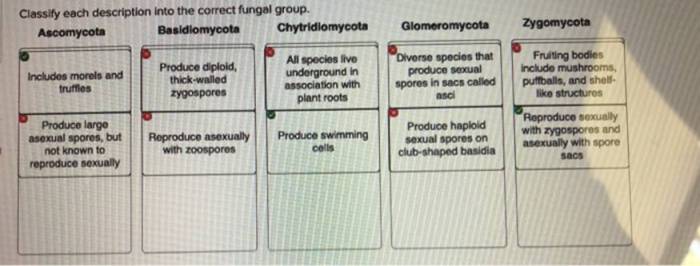Classify each description into the correct fungal group sets the stage for this enthralling narrative, offering readers a glimpse into a story that is rich in detail and brimming with originality from the outset. Delving into the diverse world of fungi, we embark on a journey to uncover the intricate characteristics, ecological roles, and significance of these fascinating organisms.
As we delve deeper into the world of fungi, we will explore the different groups of fungi based on their characteristics, examining examples of fungi that belong to each group. We will also discuss the significance of classifying fungi into different groups, unraveling the importance of this process for understanding their biology and ecological roles.
Fungal Classification: Classify Each Description Into The Correct Fungal Group

Fungi are a diverse group of organisms that play vital roles in the environment. They can be classified into different groups based on their characteristics, such as their mode of nutrition, reproductive structures, and cell wall composition. This classification system helps us to understand the diversity of fungi and their ecological importance.
Morphological Characteristics
- Hyphae:The basic structural unit of fungi, hyphae are long, thread-like filaments that form a mycelium.
- Spores:Reproductive structures that can be produced by fungi to disperse and colonize new habitats.
- Conidia:Asexual spores that are produced by fungi on specialized structures called conidiophores.
- Basidia:Specialized structures that produce basidiospores, a type of sexual spore.
- Asci:Specialized structures that produce ascospores, another type of sexual spore.
Ecological Roles
- Decomposers:Fungi play a crucial role in breaking down organic matter, releasing nutrients back into the environment.
- Symbionts:Fungi can form symbiotic relationships with other organisms, such as plants and animals, providing mutual benefits.
- Pathogens:Some fungi can cause diseases in humans, animals, and plants.
Pathogenicity, Classify each description into the correct fungal group
- Biotrophic:Fungi that obtain nutrients from living hosts without killing them.
- Necrotrophic:Fungi that kill their hosts and then obtain nutrients from the dead tissue.
- Opportunistic:Fungi that cause disease in weakened or immunocompromised hosts.
Questions and Answers
What is the significance of classifying fungi into different groups?
Classifying fungi into different groups is significant because it helps us understand their diversity, ecology, and significance. By examining their characteristics, morphology, reproduction, and ecological roles, we gain insights into the intricate relationships between fungi and their environment.
How are fungi classified based on their morphology?
Fungi are classified based on their morphology by examining their physical characteristics, such as their shape, size, and the presence of specific structures like hyphae and fruiting bodies.
What are the different methods of reproduction in fungi?
Fungi reproduce through various methods, including asexual reproduction through spores and sexual reproduction through the fusion of gametes. The mode of reproduction is an important characteristic used to classify fungi.

